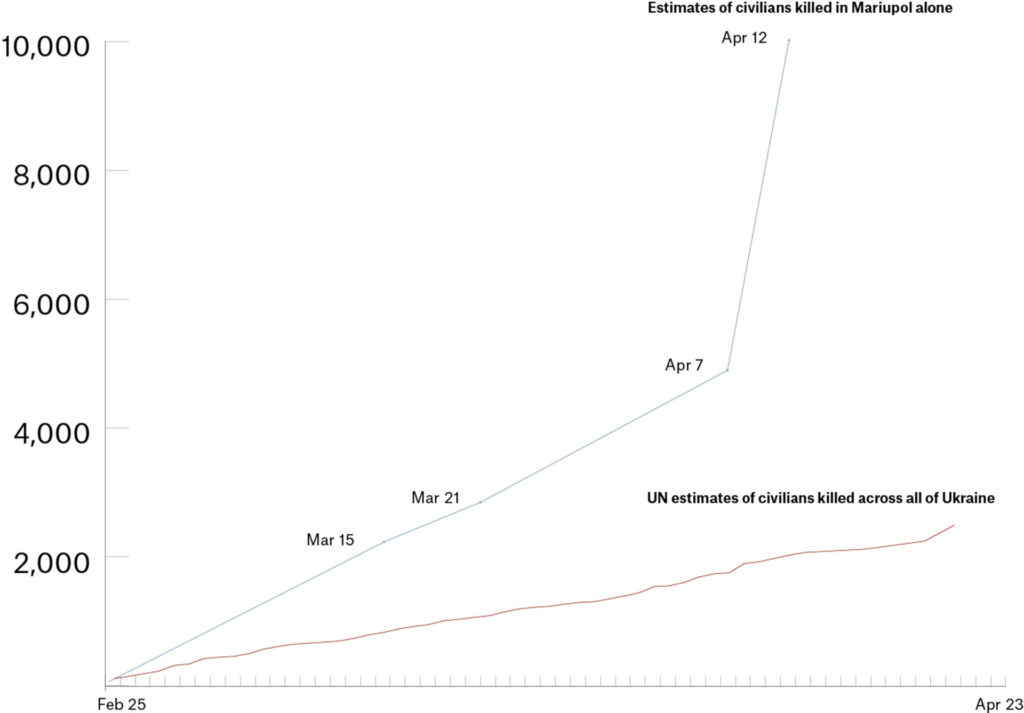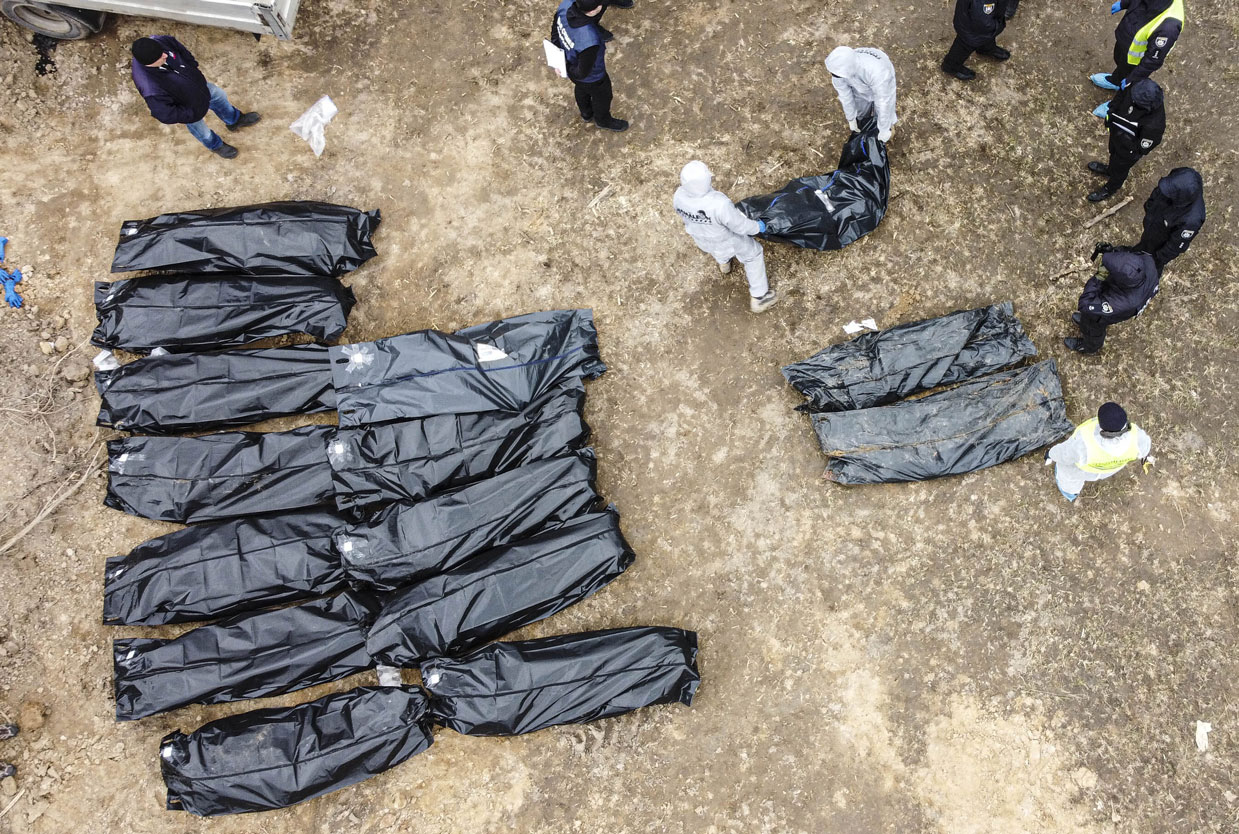In 2018, a small part of the Ukrainian military began gathering data about civilian harm in ongoing fighting in Donetsk and Luhansk, two Ukrainian regions in the Donbas, seized by Russian-backed groups four years earlier. It was a rare move, one of only a handful of militaries around the world to have established such detailed monitoring of the civilian consequences of war.
Then, in February, Russia invaded.
“From day one of the [invasion], on the 24th and 25th, we were on the phone with people working to support this unit and they were saying, ‘sorry, I have to hang up and go fight,’” said Beatrice Godefroy, Europe director at CIVIC, one of the NGOs that helped establish the Ukrainian military’s civilian casualty monitoring cell. Structures that had taken years to build up risked being overwhelmed by the scale of the crisis.
More than two months into Russia’s invasion, no one really knows how many Ukrainian civilians have died. The Ukrainian government hasn’t published official figures since Feb. 28 — just four days into the war. The most recent estimate from the Office of the U.N. High Commissioner for Human Rights, on May 3, puts the total minimum figure at 6,546. The U.N. admits the real number is far higher and is adjusting its methodology, while individual Ukrainian cities have published estimates that dwarf the U.N.’s figures — besieged Mariupol, alone, has estimated more than 20,000 civilian deaths. Reporting is fragmented: Some city councils have collected information, while others still face an environment too hostile to do so.
Monitoring civilian casualties during a live conflict has long been challenging. The breadth and ferocity of Russia’s campaign has added to that — with whole Ukrainian cities razed and more than 10 million people displaced so far. Images of devastation and ruin — of cities flattened by Russian besiegement and bodies abandoned in the streets — have been circulating widely, even as areas under attack have faced information blackouts.
Yet, understanding the full human impact of wars is crucial, both for the populations left behind and for any hope of justice and reconciliation to follow. Accurate casualty data can also help humanize those stories that may otherwise be lost in the endless churn of conflict.
Bekim Blakaj has spent 20 years documenting the impact of one of the last wars to rage in Europe. As head of the Humanitarian Law Center in Kosovo, he has been working with a team since the 1998-2000 Kosovo war to document every individual death during that conflict.
“Governments didn’t care enough to do it at the time,” he explains. “But [without reliable estimates of civilian harm] they would have left a space for those numbers to be manipulated, for the denial of crimes, the denial of victims. This harms the process of reconciliation, of creating a collective memory.”
In broad terms, there are three approaches to civilian casualty monitoring — counting, documentation and estimation, explains Michael Spagat, a professor at Royal Holloway, University of London, who has written extensively on the subject.
The first involves producing figures of civilian harm based on gathering broad estimates and figures from hospitals, public officials, death certificates and other kinds of institutional documentation. Often there is a database or system to go with it, but it isn’t typically made public, and this may also include “guesstimates” of the number of people affected by a specific event.
This method has the benefit of being relatively quick, but it has major limitations. Without reliable and detailed datasets, it is impossible to cross-check different figures — for example how estimates from Ukrainian city councils, hospitals and the U.N. might overlap. As such, you cannot knit together different datasets and have full confidence in each case.
“If ultimately we have the goal of a well-documented list of victims — or the events in which they’re killed — we need people to record more information than just the numbers,” Spagat said.
The second approach is documentation. This requires not just broad numbers of civilian casualties, but also specific information about each case — such as the age, name or place that civilian harm was identified. It could involve a combination of on-the-ground research and digital verification. This can also be done through open-source data and social media monitoring — with groups such as Iraq Body Count and Airwars doing this in conflicts primarily in the Middle East — or with interviews on the ground. The U.N. casualty monitoring mission in Ukraine was using this approach until Russia’s invasion.
Raed Jarrar conducted door-to-door surveys in Iraq in 2003 with CIVIC. “You end up with stories and names — someone saying, ‘my next-door neighbor was killed,’” he said. “Individual stories, individual names, the story of an attack on a bus or a convoy — that’s also putting things in context, which is as important as giving a figure.”
In the immediate aftermath of the Kosovo war, Blakaj and others began interviewing local sources and surviving family members to gather information on the missing. Later, they standardized their methodology — deciding that to confirm someone as dead or missing they needed two independent sources, one of which had to be a primary source such as an interviewee.
“We didn’t have any training,” Blakaj says. “We invented a protocol by doing it.”
It took them four years to produce their first estimates of civilian harm. Currently, their death toll from the Kosovo war stands at 13,535, with 75% being civilians. “The sooner you can start after the conflict, the closer you are to having accurate information,” Blakaj explains.
The third approach, estimation, involves taking sample sizes and extrapolating to national trends. So rather than document each individual death, which may prove impossible if the Ukraine conflict continues at this intensity for a long time, estimates are based on trends from a number of population samples. Such estimates typically produce larger figures. For example, the Iraq Family Health Survey Study Group estimated 151,000 violent deaths in the years between 2002 and 2006, based on household surveys and other simulations that controlled for factors such as a stable population. This was multiple times greater than Iraq Body Count’s estimate for the same period.
Before Russia’s 2022 invasion, Ukraine had well-established mechanisms for documentation of those killed or missing — with more than 3,095 conflict-related Ukrainian civilian deaths documented from 2014 to late 2021. But the ferocity of the current conflict has fragmented those existing networks. Organizations such as CIVIC and the U.N. agencies have seen some or all of their staff flee their homes. Many who have stayed are facing information blackouts — making it difficult to verify or document local and national civilian casualty incidents.
The U.N. also recently announced it is reworking its methodology after being “criticized heavily” for its current low estimates. The methodology from 2014 until the start of the war — which is available online — drew on a wide range of information, including forensic reports, eyewitness accounts and interviews with victims and their relatives. Uladzimir Shcherbau, the head of civilian harm monitoring for the U.N. in Ukraine, explained that it typically required at least three independent sources to confirm a death and only counted people as civilians if found unarmed.
But Russia’s invasion has seen U.N. monitors quickly become overwhelmed. “The amount of material we have to process is enormous, and the time constraints are also enormous, so we cannot go too deeply into each individual incident,” Shcherbau explained.
Their figures have been far lower than Ukrainian estimates, leading some to argue this has lent a veneer of legitimacy to the claims of those trying to downplay the Russian invasion.
The U.N. is now adjusting its methodology to gather estimates from a wider range of sources including regional authorities and official agencies. Rather than only releasing exact figures of those cases that they have corroborated, they’re hoping to soon produce a realistic estimate of the death toll from the fighting in Ukraine. This is perhaps closer to counting than documenting.
“We have a big mass of information which allows us to triangulate or somehow approximate the actual death toll,” Shcherbau said.

After the conflict ends, the U.N. team still plans to do full documentation over a long period.
Ukraine has some advantages over other environments where civilian casualty organizations operate, such as Ethiopia, Iraq and Syria. It’s relatively well-placed to find out how many civilians are harmed, and as Jarrar points out, the Ukrainian government is actively interested in doing so. “When I was collecting information in Iraq, the state had collapsed — the U.S. was occupying, and it was interested in suppressing the number of civilian casualties,” he said.
Online sleuths have also made a difference in preserving key information. Organizations such as Bellingcat and the Centre for Information Resilience, for example, have been mobilizing volunteers to document attacks on civilian infrastructure — potentially opening up avenues for further investigation and litigation when the conflict decreases in intensity.
There are plenty of news organizations producing detailed reports about mass civilian casualty events — including in Bucha, where horrific details about a monthlong campaign of cruelty and sexual violence by Russian soldiers have emerged. The Ukrainian government has also sent investigators with smartphones to look for evidence of potential war crimes.
“The amount of material online in Ukraine is extraordinary,” says Rich Weir, who has spent much of the past two months in Ukraine for Human Rights Watch. He compared it to the conflict in Myanmar last year, where the military authorities ultimately cut off internet access. “At first, there were livestreams, videos, images, more than you could possibly process — and then they cut off access. But some areas, such as Mariupol, are in an information blackout like what we saw in Myanmar, which creates a really difficult environment for documentation.”
Despite all of these efforts, it may still take years to finally understand how many civilians have been killed.
“When will the world know for sure, when hostilities are over, the exact number of civilians who have been killed in Mariupol from day one until the last day of hostilities?” Shcherbau asked. “That will surely take time to recover all the bodies, to identify them, and because there was a mass displacement — the ultimate accurate figure won’t arrive quickly.”
However long it takes, such numbers can provide a counterweight to biased narratives; and detailed documentation about the lives that were lost can humanize a brutal and bloody conflict that has devastated an entire country.
“The first step towards a peaceful situation is when we accept the facts of what happened,” Blakaj said. “Creating a collective memory reduces the chances of having a recurrence of violence.”



